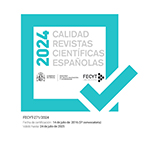Una genealogía sociológico-conceptual de la post-secularización
Resumen
Los análisis recientes de José Casanova, Jürgen Habermas, Gordon Lynch, Hans Joas, Robert Bellah, David Martin o el último Peter Berger -entre otros- han puesto el foco en las limitaciones asociadas a la teoría general de la secularización, convertida, durante décadas, en paradigma a partir del cual comprender e interpretar las relaciones entre lo secular y lo religioso. A través de la teoría de la post-secularización se ha podido re-graduar la mirada sociológica en torno a dichas relaciones, poniendo el énfasis en la vitalidad y pluralidad de formas que adquiere lo religioso en la actualidad. Partiendo de este presupuesto, el objetivo de nuestro trabajo es realizar una genealogía sociológico-conceptual de la post-secularización centrada en el análisis de algunas de las principales aportaciones teóricas que han contribuido al desarrollo de esta nueva forma de aproximación a la secularización. Dicha genealogía no se va a limitar al análisis de la obra de autores que han articulado sus propuestas como respuesta a las insuficiencias de la teoría general de la secularización, sino también queremos estudiar brevemente algunas aportaciones de clásicos del pensamiento sociológico –concretamente de Durkheim y de Weber- cuyas reflexiones ya apuntaban a un horizonte de post-secularización. Así, tras la introducción presentaremos un primer apartado centrado en estudiar el politeísmo moderno según Weber y la cosa sagrada en la obra de Durkheim. Posteriormente presentaremos tres análisis teóricos actuales, concretamente los de Habermas, Casanova y Lynch, que nos ayudarán a perfilar los contornos conceptuales de la post-secularización.
Descargas
Descarga artículo
Licencia
La revista 'Ilu. Revista de Ciencias de las Religiones, para fomentar el intercambio global del conocimiento, facilita el acceso sin restricciones a sus contenidos desde el momento de su publicación en la presente edición electrónica, y por eso es una revista de acceso abierto. Los originales publicados en esta revista son propiedad de la Universidad Complutense de Madrid y es obligatorio citar su procedencia en cualquier reproducción total o parcial. Todos los contenidos se distribuyen bajo una licencia de uso y distribución Creative Commons Reconocimiento 4.0 (CC BY 4.0). Esta circunstancia ha de hacerse constar expresamente de esta forma cuando sea necesario. Puede consultar la versión informativa y el texto legal de la licencia.











